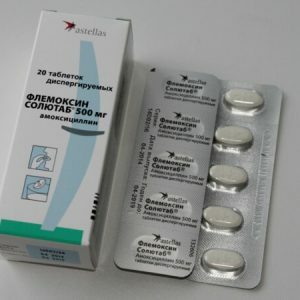Flemoxin solute: instruction, indications, analogues
 Flemoxin soluteba is an antibiotic from the penicillin group.Its active ingredient is amoxicillin.This antibiotic is prescribed for the treatment of a wide variety of inflammatory-infectious diseases, while it can be taken by both adults and children.
Flemoxin soluteba is an antibiotic from the penicillin group.Its active ingredient is amoxicillin.This antibiotic is prescribed for the treatment of a wide variety of inflammatory-infectious diseases, while it can be taken by both adults and children.
Properties preparation
 Flemoksin soljutab has a bactericidal effect.It disrupts the synthesis of the protein of the cell wall of the microbe, which leads to the destruction and death of the bacterium.
Flemoksin soljutab has a bactericidal effect.It disrupts the synthesis of the protein of the cell wall of the microbe, which leads to the destruction and death of the bacterium.
Flemoxin is available in tablets of various dosages of .After consuming the pill, the drug is absorbed quickly and almost completely.Its action Flemoxin soluteab begins to give after fifteen to thirty minutes.The maximum concentration of the drug is achieved after one to two hours.
Please note! It is noteworthy that eating actually does not affect the absorption of the drug.Therefore, unlike many other antibiotics, Flemoxin soluteab is taken without regard to when a person will eat.The medicine can be drunk before or after a meal and even directly during a meal.
The tablet can be taken as a whole, washed down with water. To the same people who are difficult to swallow tablets, you can chew antibiotic or even dissolve it in a small amount of water( 20-100 ml), so it is written in the instructions to the drug.
Analogues Flemoxin solutab:
- Amoxicillin;
- Amoxyl;
- Amofast;
- Gracsimol;
- Amosin.
Indications
Flemoksin soljutab include antimicrobial broad antimicrobial spectrum.It is especially effective against many bacteria: strepto- and staphylococcus, clostridia, neisseria, enterococcus, Escherichia coli, shigella, salmonella. Flemoksin soljutab prescribed for any inflammatory infectious diseases caused by microbes susceptible to amoxicillin:
-
 Infectious diseases of the airways and otolaryngology;
Infectious diseases of the airways and otolaryngology; - Urinary tract infections;
- Intestinal infections;
- Infectious skin lesions;
- Peptic ulcer in complex therapy.
Regimen
 Flemoksin The administered dose depends on the severity of the disease, and age of the patient.
Flemoksin The administered dose depends on the severity of the disease, and age of the patient.
P In inflammatory and infectious diseases of mild, moderate severity, Flemoxin should be taken for five to seven days by .In diseases caused by pyogenic streptococcus treatment should last at least ten days.
In general, it is necessary to focus on the clinical picture of the disease and the body's response to the administration of the drug. Flemoxin should continue to take two more days after the disappearance of signs of the disease.
For inflammatory-infectious diseases of mild, moderate severity, adults and children over the age of ten are prescribed a medicine in a daily dosage of 1-1.5 g, which is divided into two or three doses during the day.In severe infections, medication is prescribed in a daily concentration of 2.25-3 grams, divided into three doses.
Flemoxin is successfully used in pediatric practice. For young children, the dosage is much less flemoksin:
| Children 3-10 years | daily dose of 750 mg, divided into two or three doses |
| Children 1-3 years |
daily dose of 375-500 mg, divided into two or three doses |
| flemoksin The daily dose for children is calculated as 30-60 mg drug per kg child |
contraindications, side effects
Flemoxin is not prescribed to people with hypersensitivity to penicillin drugs, as well as with the patient's renal failure.It is known that the use of penicillins, in particular Flemoxin in diseases such as infectious mononucleosis and lymphocytic leukemia, causes skin rash - exanthema.And although the exantheme does not pose a danger to humans, Flemoxin is taken with extreme caution in infectious mononucleosis and lymphocytic leukemia.
It is not recommended to take the medicine for pregnant women. Flemoxin is prescribed to pregnant women only when one can not really do without it.It was established laboratory that in a small amount the medicine penetrates into breast milk.Therefore, it should not be taken if the mother feeds the baby with the breast.

The most common side effect during treatment with penicillins and in particular Flemoxin soluteba is the development of an allergic reaction.The allergy can be shown only by skin rashes accompanied by itching.More severe forms of allergy occur with edema of the mucous membranes, damage to the kidneys, joints and other disorders.A severe and rapidly progressive form of allergy can be considered anaphylactic shock, the symptoms of which are laryngeal edema, choking, falling blood pressure, blanching of the skin.Fortunately, anaphylactic shock is extremely rare.
Among the possible side effects should also highlight the change in taste, nausea, vomiting, diarrhea, anxiety, insomnia, dizziness.
Grigorova Valeria, medical reviewer



